A family member needed to make a day trip to Invercargill, so I generously offered to drive and even extended the invitation to the rest of the family. Little did they realise that they would become my captives as I seized the opportunity for a somewhat-subsidised Southland adventure.
Their first hint that something was up was when I veered off State Highway 1 at Clinton and headed straight for Mataura along the winding Old Coach Road. “We’re off to see the mighty Mataura Falls!” I announced.
We pulled up in Mataura Terrace and climbed the bank to observe the Mataura River, but what I saw was definitely not the naturally-occurring waterfall I’d been expecting.
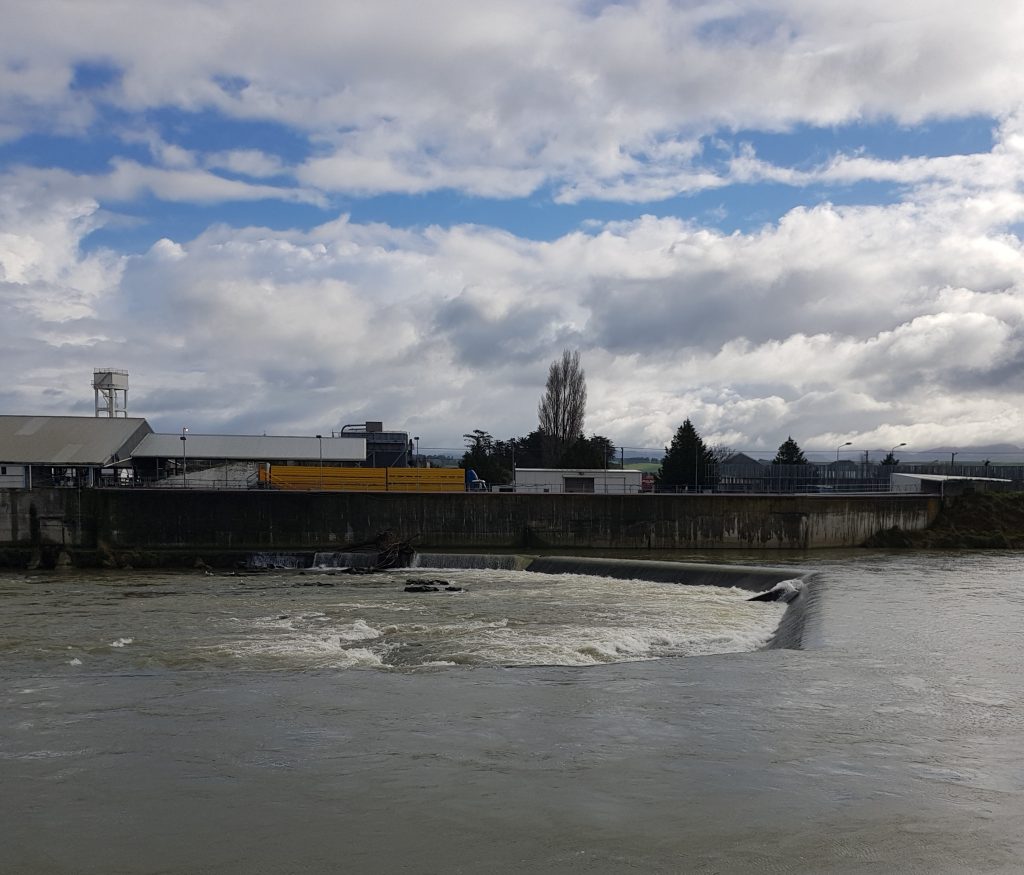
Turns out what I was seeing was the weir designed by Nathaniel Young Armstrong Wales, later to become mayor of Dunedin and whose architecture firm still survives today. Said weir was built in 1891 by two businesses on opposite sides of the river to assist in routing the water into the races that serviced their respective businesses – a freezing works and a paper mill.
We therefore had to move downstream, and as the family stayed by the bridge I ventured upstream to see how close I could get to the falls, which were placed inconveniently between industrial buildings abutting the waterway.
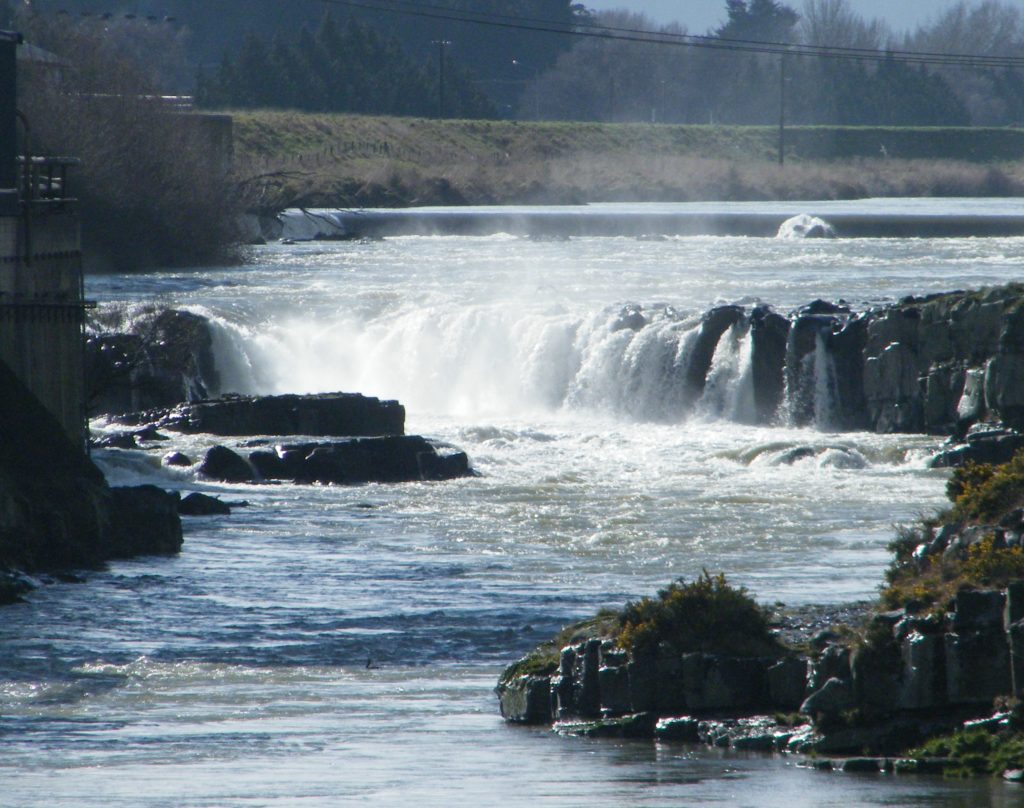
These falls were a tourist attraction for the early European settlers of the district, but their significance reaches back before Mataura was ever established as a township. It was Paroparo Te Whenua of Ngati Mamoe who first discovered the tasty taonga harboured within these waters. Following a flood, he observed from a lookout on the Hokonui Hills that gulls were feasting nearby, and investigated. Thus he discovered the migratory kanakana, or lamprey, that during September and October would climb the falls. These were traditionally gathered by the Māori who would support themselves on wooden stakes or hang by ropes as they gathered the eel-like delicacies to be dried for the winter months.
This was significant mostly because it is the reason for the existence of a traditional settlement nearby, one that would be completely unremarkable except for the fact that it was the site of the very last South Island battle between Māori.
Sadly, the falls – known as Te Aunui to the Māori – are far less spectacular than they once were, as Mataura’s European settlers blasted the rock away to combat the inconvenient spray and to improve water flow. Fortunately this area of the river was declared a mataitai reserve back in 2006, which means that its management is back in traditional hands.
I shepherded my hostages back aboard our vehicle and ferried them a little further south, pulling off at Tuturau Māori Reserve during a brief break in the weather. Whilst they prepared lunch, I headed off to explore the site.

I pressed through the bushes, crossed a narrow board bridge across a ditch, clambered over a slippery stile over a rusty barbed-wire fence, then squelched up a muddy rutted vehicle track before finding my way into a clear field. Ahead of me, on a grassy knoll lit up by a brief break in the clouds, and flanked by the rainbow, was the destination I was seeking.
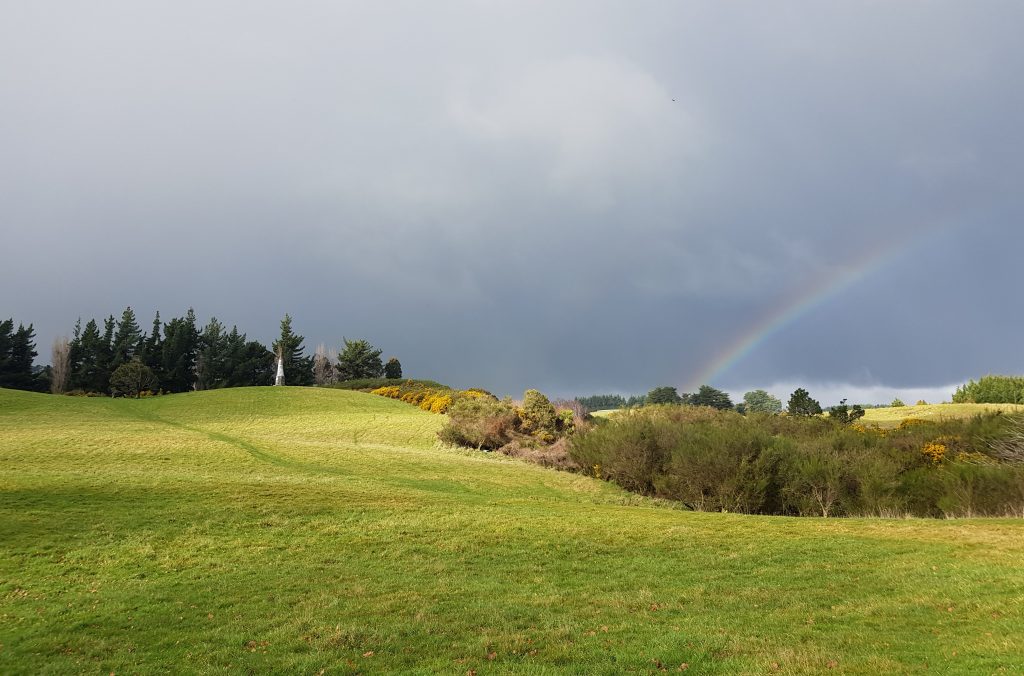
In the 1810s the first of the wars brought on by the arrival of muskets erupted. This new weaponry and the technological superiority it offered set off a cascade of invasions and migrations that rumbled southward. Under pressure from still further north, Ngati Tama from the Taranaki region, allied with Te Rauparaha’s Ngati Toa, pressed south first to the Wellington area and then to the top of the South Island, displacing the resident Ngai Tahu and all but eliminating Ngati Tumatakokiri.
Ngai Tahu struck back in several inconclusive raids, including the one that ended on Measly Beach. By the mid-1830s somewhat of a stalemate had arisen, with muskets on all sides and the new occupants of the South Island consolidating their power over their new lands.
The paramount chief of Ngati Tama at this time was Te Puoho ki te Rangi, a man in his forties and veteran of many battles. While his allies seemed content to settle in, he chafed for further raids, an ambition that alarmed his less belligerent neighbours. He concocted a daring plan, to strike at Ngai Tahu from deep within their territory, and seize their valuable industries and European contacts at Foveaux Strait.
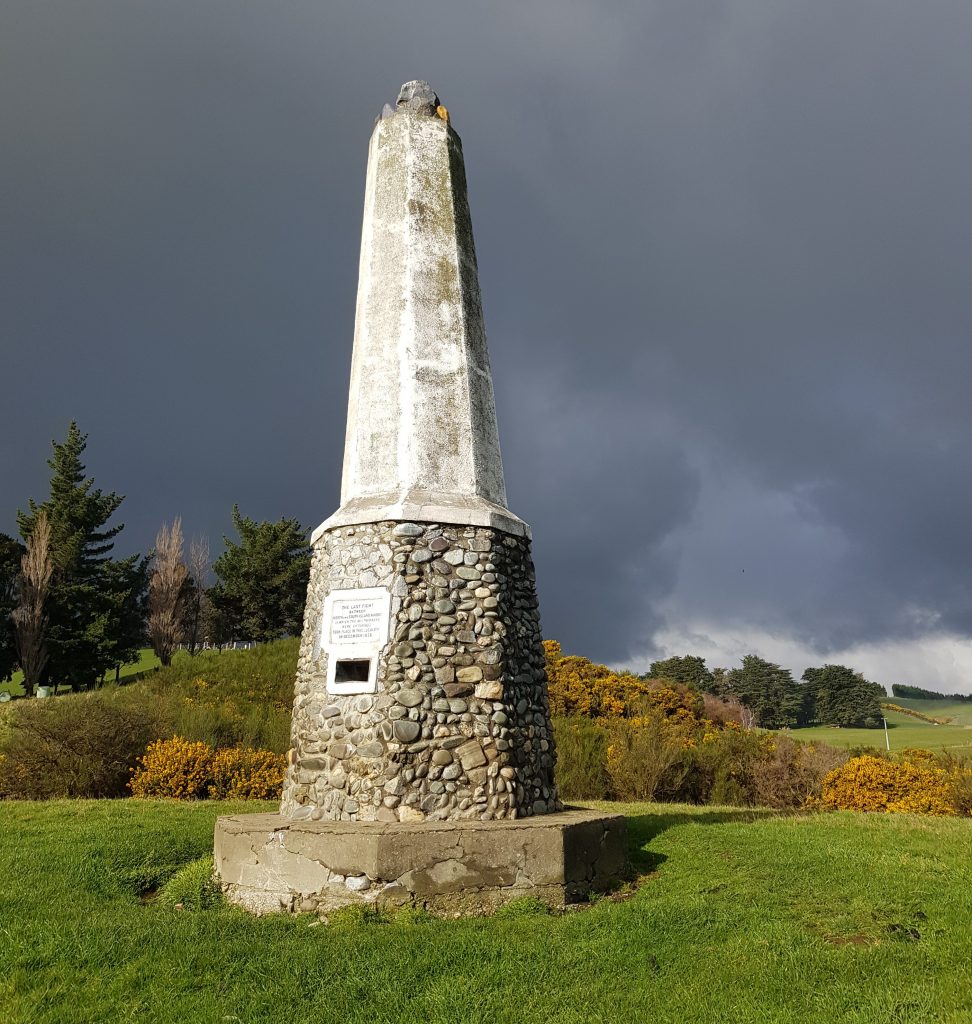
He was unsuccessful in convincing his allies to accompany him, and so set off down the West Coast in 1836 with a party of about fifty men and women. His allies on this route shut their gates to him, fearing disruption to the valuable greenstone trade they had so recently gained control of by defeating the West Coast Ngai Tahu.
So it was without swelling their numbers that his war party made their way through Haast Pass and into the Central Otago territories of Ngai Tahu. They raided a few small settlements on the way, and a young Rawiri te Maire narrowly escaped the war party’s clutches.
By the time they reached the Mataura plains they were exhausted and hungry from their epic march. The tiny settlement of Tuturau, with its few elderly caretakers in residence to tend the potato garden while the younger residents were away on eeling expeditions, presented an easy target. Famished, they uprooted the unripe potatoes and devoured them.
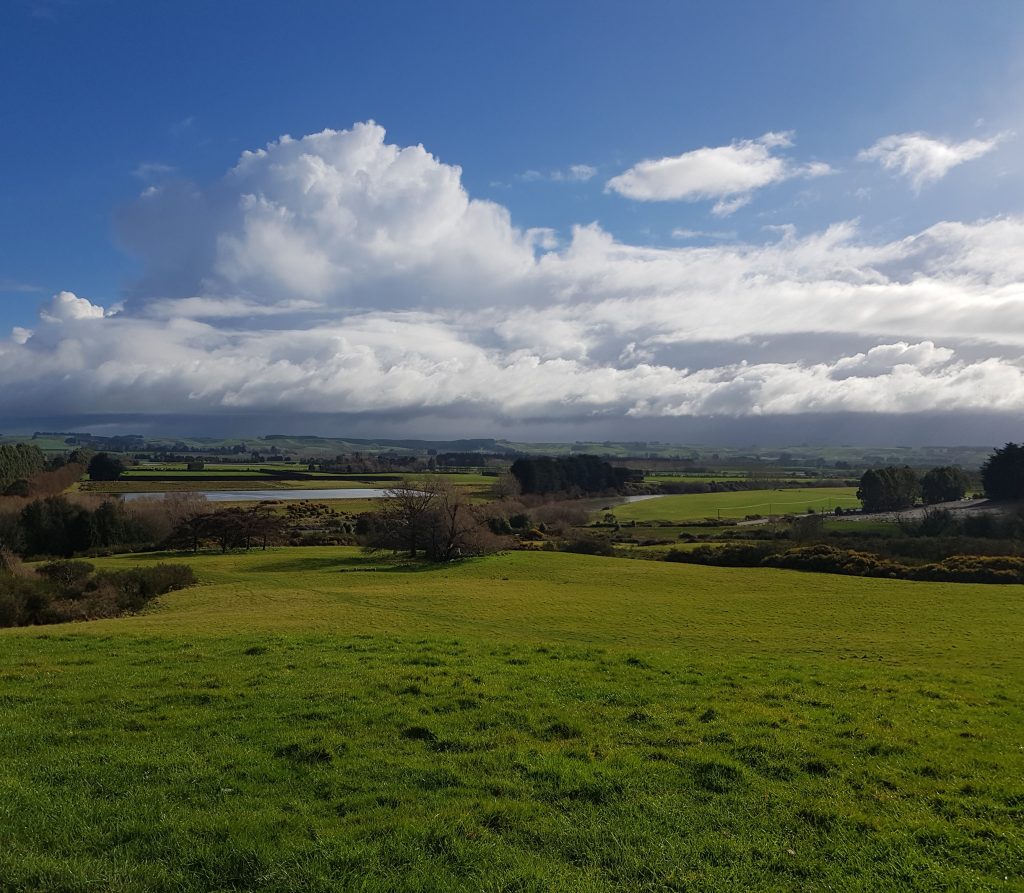
Te Puoho would have liked to keep his presence in the deep south secret for longer, but it was not to be. Word was now spreading, and very soon reached Tuhawaiki, leader of the Southland Māori, at Bluff. He immediately set out to gather a force, accompanied by his visitor Te Matenga Taiaroa of Otakou. The revenging party – likely composed of about 60 warriors – quietly surrounded the village as the invaders slept, and two men climbed the stockade to perch on the roof of one of the dwellings, where they observed Te Puoho sleeping on a verandah below.
Two shots rang out in the dawning light. The first injured Te Puoho, and the second was fatal. The camp quickly sprang to arms. A single slave was slain before Taiaroa rushed into the encampment calling for peace. Without a leader, the invaders quickly surrendered, becoming slaves to the very people Te Puoho had hoped himself to enslave.
This was the end not only for Te Puoho’s ambitions, but for the Musket Wars themselves.

This memorial was erected in 1937 (a year late) to mark the centenary of these events. It was unveiled in front of a crowd of about 3000, though the Pakeha attitude toward the whole affair can be seen as a little condescending, with the inscription criticised as being more appropriate to “an inter-island rugby match” than a serious historic event.
I’d have pondered this more, but the increasingly-threatening sky was strongly hinting that it was time for me to go. I rejoined my family just in time to scarf down a sandwich before the first icy raindrops fell. Unlike Te Puoho, our southern journey did not end here, and we had a long way to go.
References:
Mataura: City of the Falls edited by D.C.W. Muir
History Mason and Wales Practice History: 1863 – 1963 Recent History: 1963 – 2013
Whenua – Te Au Nui (Mataura Falls)
Te Puoho’s Last Raid by Atholl Anderson
Te Tau Ihu o te Waka: Aa History of Maori of Nelson and Marlborough. Volume I: Te Tangata me Te Whenua – The People and the Land by Hilary and John Mitchell
The welcome of strangers : an ethnohistory of southern Maori A.D. 1650-1850 by Atholl Anderson

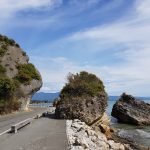


Thanks for the great post! I’m aware of these sites but haven’t visited.
As spending my first twenty one years in Mataura, found this article very interesting. As children we were often taken to the Tuturau Reserve for picnics. In those days ( 1950s) it was surrounded by bush and scrub.